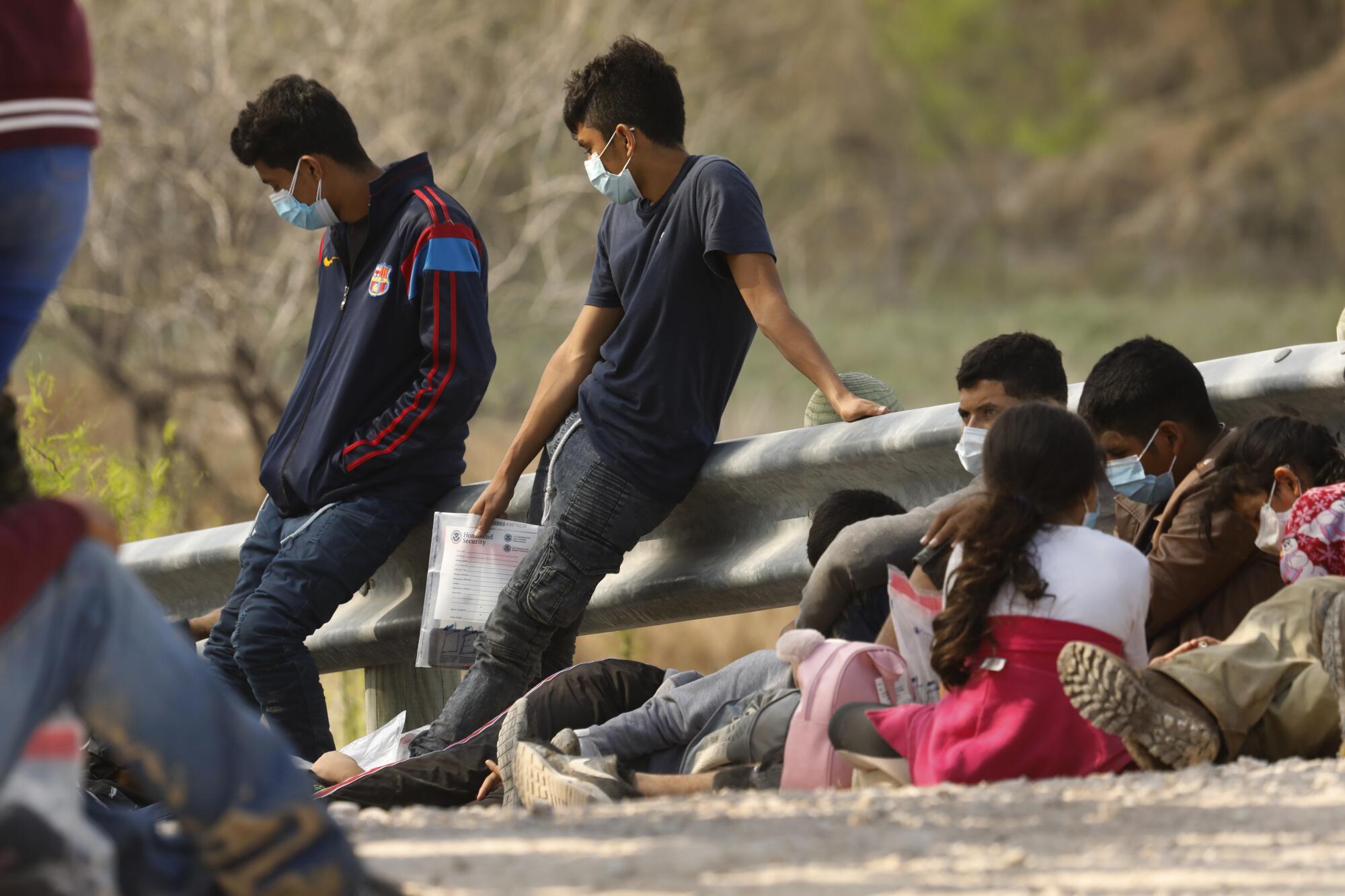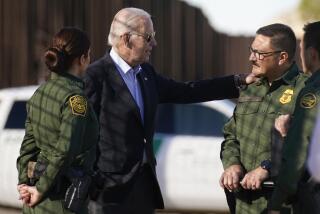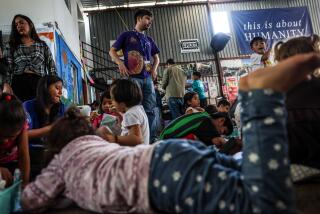
WASHINGTON — In March 2020, the Trump administration put into place one of the most controversial and restrictive immigration policies ever implemented at the U.S. border — and in January, President Biden quietly continued it.
The Biden administration says the Trump-era policy known as Title 42, which relies on a 1944 public health statute to indefinitely close the border to “nonessential” travel, remains necessary to limit the spread of the coronavirus. At the same time, Biden officials say, migrants at the southern border still can seek protection in the United States, a right afforded to them under U.S. law.
Yet since March 20, 2020, when the Centers for Disease Control and Prevention issued its order invoking Title 42, U.S. border officials have claimed unchecked, unilateral authority to summarily expel from the country hundreds of thousands of immigrant adults, families and unaccompanied minors who didn’t have prior permission to enter, without due process or access to asylum — let alone testing for the coronavirus.
In a year of Title 42, of more than 650,000 encounters with migrants at the U.S.-Mexico border, fewer than 1% have been able to seek protection, the Los Angeles Times has learned.
The Biden administration is trying to strike a difficult balance in the face of intensifying criticism that it is either pulling back on promises to undo “the moral and national shame of the previous administration,” as the president put it, or is losing control amid rising numbers at the border, wary of both the political optics and the humanitarian cost.
As Republican critics decry a “crisis” at the border, Homeland Security Secretary Alejandro N. Mayorkas said in a lengthy statement Tuesday that with the United States on pace to encounter more migrants on the southern border this year than in any of the last 20 years, the Biden administration is relying heavily on Title 42 to expel most of them.
Still, Mayorkas framed Biden’s approach as more humane, quoting one of the president’s first executive orders. “‘Securing our borders does not require us to ignore the humanity of those who seek to cross them,’” he said. “We are both a nation of laws and a nation of immigrants. That is one of our proudest traditions.”
In the last year, border authorities applied Title 42 to more than 80% of encounters with migrants, carrying out 530,000 expulsions, almost entirely away from the public eye. Generating little of the media attention now being given to more than 9,500 unaccompanied minors languishing in U.S. border jails, the expulsions included nearly 16,000 children migrating alone and nearly 34,000 children plus parents.
Out of all encounters with migrants at the border since March 2020, only 2% even made it to the initial step of claiming fear of being sent back to their home country, according to a Times analysis of data obtained from U.S. Citizenship and Immigration Services, the Homeland Security body that administers the legal immigration system, and Customs and Border Protection, parent agency of the Border Patrol.
And only 120 individuals — fewer than 1% of the total — have received and passed screenings that give them a chance — albeit a narrow one — at winning protection and being allowed to stay in the United States.
A number of lawyers and lawmakers, as well as United Nations officials, say that the near impossibility of winning protection under Title 42 makes the policy illegal, and by continuing the policy, the Biden administration is violating U.S. and international law, as its predecessor did. At least three federal judges have also determined that the policy is likely unlawful.
“The Biden administration’s use of Title 42 is flatly illegal,” said Lee Gelernt of the American Civil Liberties Union, who sued the Trump administration over the policy, which the Biden administration is defending in court. “There is zero daylight between the Biden administration and Trump administration’s position.”
Trump officials claimed that Title 42, an obscure, 77-year-old public health authority that had never before been used to regulate immigration, superseded all other U.S. laws, including statutes that grant migrants the right to seek asylum; prevent the persecuted from being returned to countries where they would face threats, harm or torture; and protect unaccompanied children vulnerable to being trafficked — not to mention constitutional due process protections.
When the Trump administration implemented Title 42, lawmakers — including then-Sen. Kamala Harris — called it an unconstitutional “executive power grab” that had “no known precedent or clear legal rationale.”
Asked by The Times whether they believe the policy is illegal now that the Biden administration has continued it, five Democratic lawmakers declined to comment.
Biden on Feb. 2 issued an executive order calling for the CDC and Homeland Security to review Title 42. Justice Department lawyers defending the policy in court Feb. 18 noted that the CDC had decided to “temporarily except” unaccompanied children “pending its forthcoming public-health reassessment.”
Yet even as the president said in a national address March 12 that all Americans should be able to gather outdoors in small groups by July 4, officials have largely sidestepped questions of a timeline or any metrics for lifting Title 42 and reopening U.S. borders.
The White House and the departments of Homeland Security, Justice and Health and Human Services (of which the CDC is a part) declined to provide The Times with any scientific or legal analysis of Title 42, its continued necessity or its purported authority to override all other federal statutes. Neither have they provided it to lawmakers who officially requested it.
In court filings and statements in recent days, Biden officials have doubled down on the Trump administration’s defense of Title 42.
In December, then-CDC Director Robert Redfield, who issued the Title 42 order, responded to requests for information from U.S. Rep. Judy Chu (D-Monterey Park), saying “ongoing litigation” prevented him from providing responses on asylum and unaccompanied children.
“The Coronavirus Disease 2019 (COVID-19) pandemic is the most significant public health challenge to face our nation and the world in more than a century,” he wrote in the letter, which was shared with The Times.
Biden officials say it’s up to the CDC to decide when to lift the order. Yet CDC officials say Trump aide and immigration hard-liner Stephen Miller and former Vice President Mike Pence pushed through Title 42 to achieve long-held political goals of restricting immigration and blocking asylum seekers — not for public health considerations. Experts at the CDC said the policy would do little to stanch the spread of the coronavirus.
By February 2020, Customs and Border Protection was holding separate meetings with the White House on how to use public health authorities to shut down the border, said Elizabeth Neumann, who was a Homeland Security official at the time.
“I’m not suggesting anybody was excited there was a pandemic,” Neumann told The Times. “It was a silver lining for them.”
Chu, who called Title 42 unlawful, told The Times in a statement, “The lack of data or justification make clear, the point was to further harass and isolate immigrants.” By contrast, Chu asserted, the Biden administration “is working on a policy that will fit our nation’s needs, not further white nationalism.”
But Biden officials are using the same justification for Title 42 that dozens of epidemiologists and other public health experts, including those with CDC experience, have rejected as “specious.” One group wrote that Title 42 was “using the imprimatur” of the CDC to “circumvent laws and treaty protections designed to save lives.”
While the Trump administration issued air travel restrictions on dozens of countries and cited Title 42 to restrict travel over the northern and southern land borders, the policy in practice almost exclusively bars migrants and asylum seekers at the border with Mexico.
Workers, students and tourists can still freely cross back and forth from Mexico at ports of entry. In the first six months of Title 42, more than 40 million pedestrians and passengers in cars, trucks, buses and trains entered the U.S. at the southern border. At the same time, overall immigration to the U.S. declined more than 90% — the largest drop-off in history.
Dr. Michele Heisler, a professor of internal medicine and public health at the University of Michigan and the medical director of Physicians for Human Rights, noted that Title 42 was put into place when the United States had more coronavirus cases than any other country. As officials have started testing some migrants let into the U.S., they’ve found “very low rates” of positive cases, she said.
“Keeping the policy in place really is deceitful,” Heisler said. “Our government talks to us about public health but perpetuates basically a lie that there is any public health reason for doing this.”
In reality, Title 42 is operating precisely as intended: For the first time under the modern U.S. immigration system, people who come to the border and say they fear persecution or torture in home countries are expelled, with no chance to make their case.
Applying for asylum — the most common form of relief from deportation — takes almost two and a half years on average, a rate that is fueling the current record backlog of 1.3 million cases in immigration courts. If an immigration judge grants applicants asylum, they can become legal permanent residents and eventually U.S. citizens, and can bring their families. But fewer than 40% of applicants are granted asylum.
Today, though, when a migrant is encountered at the border, whether at an official entry or not, a Border Patrol or CBP officer immediately decides whether the person will be processed under the CDC’s public health authority through Title 42, with no access to asylum, or under Title 8, the body of federal law dealing with immigration, which requires access to asylum.
Under Title 42, agents take migrants’ biometric information and perform a cursory health check for COVID-19 symptoms before returning them to Mexico, if they are from Mexico or Central America, or flying them back to their home country. Trump appointees boasted that Title 42 processing takes roughly 90 minutes on average.
At the same time, officials have pushed back against court rulings ordering releases of migrants from custody amid the pandemic by arguing that detention facilities are safer than releasing them. Most migrants arriving at the border have relatives in the U.S. who can sponsor them.
Outside of Title 42, CBP personnel are required to ask migrants they apprehend if they fear returning to their home country or being removed from the United States. But under Title 42, according to officials, only migrants who spontaneously claim fear can seek protection — Border Patrol agents told The Times they are not allowed to ask — and only under the Convention Against Torture — a much higher standard of proof, with stricter criteria than asylum.
Only then do border authorities refer migrants to a CAT screening with a trained asylum officer from U.S. Citizenship and Immigration Services. If granted, status under CAT allows applicants to lawfully work in the United States while their removal is blocked or deferred but not to become permanent residents or to bring family.
CBP stresses that its officers “have no discretion” during immigration processing on whether to refer an asylum seeker for an interview and “do not make any determination on the validity of such claims,” leaving that to the asylum officers. But under Title 42, “USCIS defers to CBP on their determination whether to place someone into Title 42 or Title 8,” Citizenship and Immigration Services spokeswoman Victoria Palmer told The Times.
Today, Border Patrol agents are making both the initial and — in the vast majority of cases — final decision over who gets to stay, giving law enforcement unprecedented power over the fate of vulnerable populations. And Biden officials have given no indication that they intend to scale back this power.
“A discretionary choice by a Border Patrol official on who is entitled to an asylum hearing and who is not is illegal,” Gelernt said. “Everyone is entitled to an asylum hearing.”
Both the Trump and Biden administrations have declined to share the guidance given to CBP personnel on how to make the high-stakes decision of whether a migrant will be put into Title 42 and expelled or whether he or she will receive an asylum screening.
Still, the default under Title 42 is expulsion — CBP spokesman Justin Long told The Times that exemptions require a supervisor’s approval. Mayorkas said Tuesday there are only “limited exceptions” to the expulsion policy; for example, “individuals with certain acute vulnerabilities.”
In January, just a few days before Biden’s inauguration, border agents described drastically varied understandings of the Title 42 policy. One in San Diego said migrants have to volunteer that they specifically fear torture back home in order to get a screening before they’re expelled. Meanwhile, an agent in Calexico said they routinely ask migrants if they are afraid, and if there’s any suggestion of fear, the agents process them under Title 8 and refer them for an asylum screening.
An internal Border Patrol memo last spring acknowledged growing concerns over the legality of its pandemic crackdown. The memo read: “Legal scrutiny arises for USBP’s application of T-42 authorities.”
While questions over CBP’s legal authority under Title 42 remain, the consequences are clear.
Since last March, CBP has referred 1,775 cases — fewer than half of 1% of total encounters — to Citizenship and Immigration Services for a CAT screening under Title 42. In only about 20% of encounters in the last year have border authorities not expelled the migrants and put them into Title 8 instead.
Of the nearly 122,000 put into Title 8 in the last year, CBP has referred fewer than 12,000 to a credible fear screening, according to USCIS — and about 5,000, or 43%, have passed.
By comparison, in 2019, which saw one of the highest levels of migration to the border in decades, about 15% — more than 145,000 people — were referred to a credible fear screening, according to CBP. USCIS data show that 74% passed.
In other words, under Title 42, the pass rates for those who managed to make it to the initial step — the credible fear screening — have dropped by more than 40%.
The irony of the Title 42 policy is that it appears to be incentivizing what border officials call “recidivism,” or repeat crossings. In contrast to deportation, there is no adverse legal consequence to being expelled, agents told The Times.
With no legal pathway to enter, migrants increasingly turn to smugglers, and the coyotes are given as many attempts as necessary for the price of one. In February, about a third of encounters were the same migrants making repeated attempts to cross — falsely elevating migration numbers and reflecting the existing backup at the border, officials say.
Title 42 is also helping to spur a demographic shift: In 2019, the vast majority of apprehensions were of Central American families and unaccompanied minors seeking out, rather than evading, Border Patrol in order to claim asylum. Today, the vast majority to make the crossing are single, adult, Mexican males — more closely resembling the demographics of the 1980s through early 2000s, when annual apprehensions, a rough measure of illegal immigration, routinely topped 1 million. In the year since Title 42 was enacted, single adults have made up nearly 85% (almost 550,000) of all encounters at the border — and around 88% of them have been expelled. Unaccompanied minors made up only 7% of encounters, and families with children accounted for fewer than 9%.
Still, the Biden administration is shifting its expulsion policy in response to a steady escalation of lone children and families with kids coming to the border in recent weeks. Pandemic restrictions have left thousands stuck in ill-suited, overcrowded Border Patrol facilities far longer than the allowed 72 hours. More than 80% of those migrants have a family member in the United States, Mayorkas said.
In November, a federal judge ruled that the government couldn’t use the pandemic as a reason to expel unaccompanied minors. But in January, a federal appeals court lifted the preliminary injunction, again allowing the government to expel lone migrant children. A few days later, the White House announced that it would no longer expel unaccompanied kids.
Biden officials point to that decision as an example of the break they are making from their predecessors.
“The Trump administration expelled children to Mexico,” Mayorkas said in a White House briefing this month, “and we are not expelling young children.”
But the Biden administration’s decision to exempt lone migrant children from Title 42, and to scale back the policy’s use against families, was motivated at least in part by a new law in Mexico that bars authorities from holding children and families in immigration detention. Mayorkas said Tuesday that U.S. officials are allowing some families in, but primarily because Mexican authorities are refusing to accept them.
The courts may yet force the Biden administration’s hand. A few weeks ago, Gelernt said, the ACLU agreed to hold its lawsuit against Title 42 expulsions for a month to discuss the administration’s plans to stop using it on families.
“We’ve seen no real progress,” he said. “I suspect we will be back in court next week.”
More to Read
Get the L.A. Times Politics newsletter
Deeply reported insights into legislation, politics and policy from Sacramento, Washington and beyond. In your inbox three times per week.
You may occasionally receive promotional content from the Los Angeles Times.











